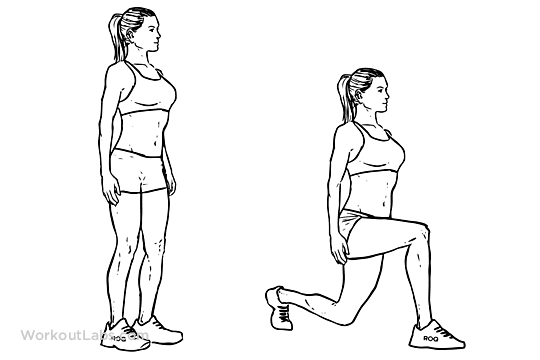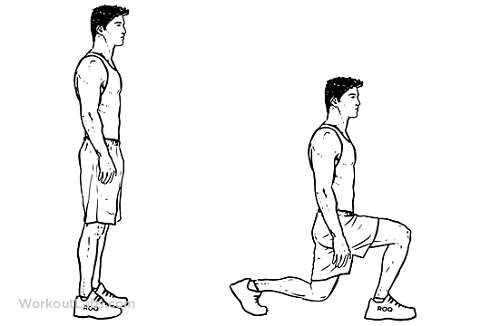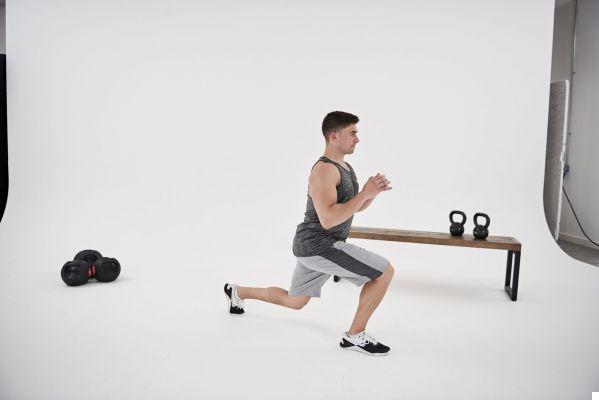For lunges in motion we want to refer to a one-sided exercise for the lower body, legs and thighs and buttocks, performed in a kind of walking.
The aspect of moving adds a good dose of instability to the exercise and consequently increases the work of the stabilizing muscles or abdominal and hip fixators.
Walking lunges are a decidedly challenging complementary exercise and fit well as a second exercise in a leg card or at the end of a workout as a burn out or as a stage in a HIIT workout.

execution
Execution is as follows, regardless of the use of external overload:
- Start from a standing position.
- Bring one leg forward without aligning the two feet. This means that the lateral distance between the two feet must always be around the distance between your hips (pelvis width).
- Flex the knee of the leg that is brought forward. at the same time flex the knee of the leg that has remained stationary. The weight should remain mostly on the forward leg. the ROM must be such that the knee of the rear leg touches the ground.
- From this position push down with the front leg and simultaneously push back with the buttocks. The movement is a knee extension accompanied by a hip extension. This movement should allow you to move forward with the rear leg which at this point becomes the front one.
- Repeat the same sequence for the other leg.
- This is a repeat.
You can insert a pause between switching from one leg to the other. If you choose this option, the movement becomes more stable.

Generally this variant is chosen to better perform large lunges or if you want to bring the leg far forward compared to the stationary one.
This second variant reduces the ROM of the knee by increasing that of the hip.
Both variants are valid, the first (narrow lunge) allows you to work more on the quadriceps while the second (wide lunge) allows you to work more on the hamstrings and buttocks.
If you want to use weights you can grab dumbbells with both hands, with one hand or use a barbell placed over the shoulders.
Using two dumbbells allows you to involve a lot of grip (especially if you use significant overloads) and also makes it easier to collapse because if you lose your balance it is enough to let go of the dumbbells.
Using only one dumbbell definitely destabilizes the exercise (particularly if the weight is high) by recruiting a lot of the obliques and the counter-lateral hip abductors.
The barbell variant allows for greater overload, however, creating a relatively precarious balance compared to the variant with two dumbbells.
Furthermore, if you use a barbell, it is not a good idea to collapse because you risk falling along with the barbell on your shoulders.
Muscles involved
The muscles involved are practically all starting from the shoulders to the legs.
If you use dumbbells and keep them away from the pelvis, the lateral deltoids, the upper trapezius and even the supraspinatus are very involved.
The anterior core muscles (abdominal and oblique) must stabilize the trunk in an increasingly important way as the overload increases.
The hip stabilizers must maintain proper alignment in a non-equilibrium position.
The spinal erectors must resist the weight that tends to bring the trunk forward, but remain in a low risk situation because one hip is extended and therefore makes it more difficult to lose lumbar alignment.
The people directly affected by this exercise are certainly the muscles of the thighs and hips: quadriceps and glutes first of all.

Common mistakes
A common mistake is to line up your feet in front of each other. This causes both hips to rotate and thus put stress on the knees.
Another mistake is to hyperextend the lower back, this leads (in the long run) to compressive stress on the back which manifests itself in pain.
To avoid this condition, it is helpful to actively contract the buttock of the rear leg before flexing the knee (lunge phase).
If this step is done correctly you should feel good stretching in the upper front of the thigh or in the hip flexors.
These muscles are often shortened and sometimes do not allow maximum contraction of the hip extensors (especially the buttocks).
This step allows you to use a greater ROM in the hips and it is better to use a medium lunge to limit the elongation of the hip extensors (you cannot expect to immediately obtain maximum elongation in a muscle district that has always been shortened).
A final mistake is to place the tip of the foot first and then the rest of the foot.
This leads to unnecessary stress on the front knee; first place the heel and then the metatarsus.


























